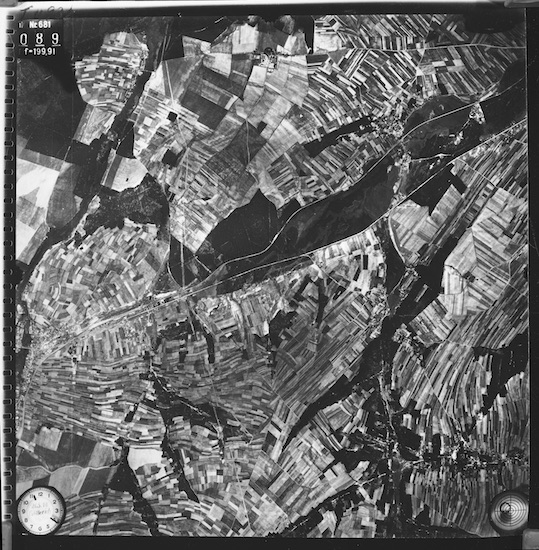This post is also available in: Français Español العربية فارسی Русский Türkçe
How much wood was needed for the mass cremations at the Operation Reinhard death camps? (Part 2 of 2)
Holocaust deniers claim:
Some 96,000 tons of wood would have been needed to incinerate the bodies of the 600,000 Jews murdered in Belzec. That amount of wood was not available.
Carlo Mattogno, an Italian Holocaust denier, states that 96,000 tons of wood would have required stripping an area of mature woods 30 times greater than the area of the camp. And, according to aerial photographs taken in 1945, there were still plenty of trees in the area.[1]
The facts are:
The evidence shows that the calculations of Holocaust deniers, about the amount of wood needed to cremate the bodies of the Jews murdered at Belzec and Sobibor, is inflated by about six times over. Estimates indicate much lower wood requirements. Enough of this wood was available in the area.
Data pertinent to wood usage in the camps:
Every year large numbers of animals must be destroyed because of disease. Their carcasses present a public health problem and they have to be quickly and thoroughly destroyed.
Health officials have found that they can burn 41,300 kilograms (about 91,050 pounds) of swine carcasses with 40 cubic meters of firewood (about 24,145 kilograms of wood.) This means that to incinerate 1 kilogram of carcass about 0.58 kilograms of wood is required.[2]
Experts in the field note that “a good rule of thumb is that you need roughly in tons the same amount of wood waste as the weight of the carcasses . . . For 5 tons of carcasses you need 4-5 tons of wood waste. If you were to incinerate a lot of bones, much less wood waste would be needed.”[3]

Photo Credit: United States Holocaust Memorial Museum, courtesy of National Archives and Records Administration, College Park
Informed and realistic numbers for the amount of firewood needed:
We will use an average body weight of 25 kilograms (about 55 pounds), which takes into account the weight of bodies in various stages of decomposition (about 14-35 kilograms).
600,000 bodies x 25 kg of weight each = 15,000,000 total kg of body weight
15,000,000 kg x 1 kg of wood per kg of body weight = 15,000,000 kg of wood
15,000,000 kg of wood = 15,000 metric tons of wood
Thus, Mattogno’s figure of 96,000 metric tons is too high by a factor of at least 6 times.
Where did this firewood come from? Would the area around the camps have been stripped bare?
In all three camps, Jewish work groups cut and hauled wood to the camp every day, sometimes from as far as five kilometers away. The wood was used to fuel the incineration grills and to refurbish the branches woven into the fences for camouflage. The old branches for the fence made good tinder for starting the incineration fires.
Thomas Blatt, who survived Sobibor, recalls that he volunteered to work for the forest commando: “The work performed there also took place outside the barbed wires of the camp. This particular group supplied wood for the crematorium by cutting down trees and digging out the stumps.”[4] As to where the wood came from, Blatt recalls: “When there were no more saplings in the immediate area, he put me in charge of a group of tree cutters deeper inside the forest.”[5]
Aerial photographs taken in 1940 before Belzec was established show the camp site to be heavily forested. An aerial photograph taken in 1945 (two years after the camp was closed) shows the nearby area of the camp largely stripped of trees, some of which were removed in order to build the camp. This deforestation is consistent with the wood requirements, if one uses more realistic figures than those invented by Holocaust deniers.[6]
Conclusion:
Mattogno’s calculations about wood requirements per kilogram of bodies are inflated by about six times over. Proper estimates of needed firewood take into account a variety of factors: the actual state of two-thirds of the bodies (dried out skin and bones), the ages of the victims (one-third to one-half children and infants), the correct average body weight estimates, and more responsible figures for the amount of wood required.
The wood, according to the testimony of multiple eyewitnesses, was taken from around the camp and from other sites kilometers away. The de-forestation of the area is consistent with the amount of wood required.
NOTES
[1] Carlo Mattogno, Belzec in Propaganda, Testimonies, Archeological Research, and History (Theses & Dissertations Press, 2004), p. 85 at http://vho.org/dl/ENG/b.pdf.
[2] “Carlo Mattogno on Belzec Achaeological Research—Part 4(2), (“4.2 Wood Requirements”) at http://holocaustcontroversies.blogspot.com/2006/05/carlo-mattogno-on-belzec_28.html citing “Options for the Mechanised Slaughter and Disposal of Contagious Diseased Animals—A Discussion Paper by R. D. Lund, I. Kruger and P. Weldon.”
[3] “Carlo Mattogno on Belzec Achaeological Research—Part 4(2), (“4.2 Wood Requirements”).
[4] Thomas Toivi Blatt, From the Ashes of Sobibor: A Story of Survival (Northwestern University Press, 1997), p. 112. For more accounts of cutting wood see also Abraham Krzepicki, “Eighteen Days in Treblinka” in Alexander Donat, editor, The Death Camp Treblinka: A Documentary (Holocaust Library 1979), p. 124; Samuel Willenberg, Surviving Treblinka, edited by Wladyslaw T. Bartoszewski, translation by Naftali Greenwood (Basil Blackwell, 1989), p. 110; Richard Glazar, Trap with a Green fence: Survival in Treblinka (Northwestern University Press, 1992), pp. 127-135.
[5] Thomas Toivi Blatt, From the Ashes of Sobibor: A Story of Survival (Northwestern University Press, 1997), p. 110.
[6] You may see these photographs at “Belzec Maps” at http://www.deathcamps.org/belzec/maps.html.

